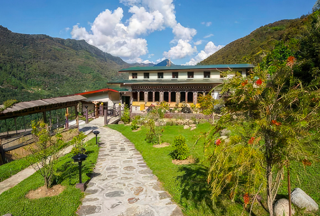Imagine the vast moors in Gothic English literature surrounded by the high ridges, hardened by centuries-old rocks. They say people lose their way here, in the home of the mystical yeti. Welcome to the lost trail of Brigdungla. This is a new gift to Bhutan’s tourism – A trail that has never been trekked before except by yak herders of these highlands.
The Brigdungla trail is a four day trek. You will traverse along the scenic pine forests, vast rhododendron shrubs, and dozens of lakes to reach the highest point of about 4600m. Locals say that there are actually 108 scattered lakes around this region, in addition to the beautiful valley views and a tiger habitat. You will get to see a huge portion of the views that you see along the one month snowman trek.



Day 1 – Arrive Paro Valley & Journey to Capital Thimphu. Acclimatize – (Lunch/ Dinner)
The gateway to Bhutan. Home to Paro Airport, the only international airport. This is where you begin the journey to the land of happiness. Average elevation of 2300 metres above sea level.
The bountiful and fertile Paro Valley is the entry point for all visitors flying into Bhutan on the national carrier, Druk Air.


As the plane takes a dramatic sweep into Paro, the flight captain usually warns relieved passengers not to worry if the aircraft’s wings appear to be almost touching the mountainsides. The first thing you will notice as you exit from the aircraft is the crystalline purity of the air that you breathe. As you take your first breath of the air in Bhutan, you will notice that Bhutan is unlike any other country you have visited.
This is especially true If you hail from the urban city life where the air tends to be polluted. Take a moment, and enjoy the fresh air Bhutan can offer you. Located 1 hour away is the capital Thimphu. Its a beautiful drive.
Your Druk Heritage team will be there at the airport waiting for you as you exit the airport to give a warm Bhutanese welcome. Take a short walk to Tachogang Lhakhang located near the Paro-Thimphu highway.
It is a very picturesque place. One can cross the bridge to the other side and take a short blissful walk. Your guide will be able to tell you all about the history of the places visiting.


The Kingdom’s capital city – Thimphu – is home to approximately 100,000 inhabitants including the Royal family. This bustling little city is the main center of commerce, religion and government in the country. The juxtaposition of ancient tradition and modernity make Thimphu the ideal location for visitors to break away from their tour itinerary to immerse themselves in the contemporary Bhutanese lifestyle.
Thimphu is the most modern city in Bhutan with an abundance of restaurants, internet cafes, nightclubs and shopping centres. However, it still retains its’ cultural identity and values amidst the signs of modernization. Thimphu is one of the few towns in Bhutan that have been equipped with ATM banking facilities and is a good place to stock up on some local currency.
Opon arrival. Lunch will be planned for you at a local restaurant and food will be personalized as per your preference. Check into your hotel, freshen up and lets take a relaxing sightseeing tour of Thimphu. Tashichho Dzong, ‘Fortress of the Glorious Religion’ or ‘Fortress of Auspicious Doctrine’, or popularly known as Thimphu Dzong, is an impressive structure that houses the throne room and offices of the king, the secretariat and the ministries of home affairs and finance. Other government offices are housed in the buildings nearby Tashichho Dzong.
It’s been the seat of the Royal Government of Bhutan since 1962 after the capital moved to Thimphu from Punakha. The dzong is located close to Thimphu town, on the right side, next to the banks of Wang Chhu River. It’s a huge majestic structure surrounded by beautiful gardens and well-kept lawns. There are thirty temples, chapels and shrines within TashichhoDzong.

In the evening, explore Thimphu town on your own or with your guide. Dinner will be planned for you at your hotel. Overnight at Thimphu.


Day 2 – Thimphu to Bumthang Valley. Acclimatize
Breakfast at the hotel and today we drive to Bumthang via Dochula Pass. There are splendid views of the distant Himalayas at Dochula pass (alt. 3,050m) on Thimphu to Punakha highway.
One can enjoy the magnificent view of the mountains while sipping your tea or coffee here at the cafeteria where we will halt for a bit. One can explore the 108 temples built here and learn a bit of history of this site from your personal guide.
We will be on the road most of the day today but you will enjoy the beautiful pristine natural environment Bhutan has to offer and the stunning view of the mountains, witness the local people and their villages that come across the way. We will make occasional stops at gorgeous locations for pictures and for tea, coffee breaks and lunch break.
(Breakfast/ Lunch/ Dinner)
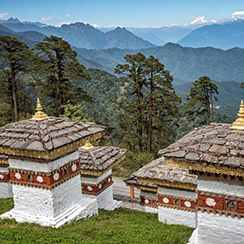

Trongsa (alt. 2,200m/7,200 ft) – forms the central hub of the nation and is historically the place from where attempts at unifying the country were launched.
Both His Majesty King Ugyen Wangchuck, the Penlop of Trongsa, who was elected the country’s first hereditary monarch and his successor, King Jigme Wangchuck, ruled the country from Trongsa ancient seat.
The Crown Prince of Bhutan normally holds the position of the Trongsa Penlop prior to ascending the throne. including the present King. The entire landscape around Trongsa is spectacular. If time permits, we will make a quick visit to the fortress.
Bumthang or Jakar valley (alt. 2600m-4500m / 8530ft-14765ft).
Bumthang has an individuality that charms its visitors and separates it from other regions. Comprising of four smaller valleys namely Tang, Ura, Choekhor and Chumey, the deeply spiritual region of Bumthang is shrouded in religious legend.
Bumthang is also the traditional home to the great Buddhist teacher Pema Lingpa (The treasure revealer) whose descendants the present dynasty traces its origin.
Upon arrival check into the resort and dinner will be at the resort. Overnight in Bumthang.
Day 3 – Bumthang Valley. Acclimatize – (Breakfast/ Lunch/ Dinner)
We will begin our day by exploring the nearby valley. According to legend, Jambay Temple or Temple of Maitreya in Bumthang is said to be one of the 108 temples built by the Tibetan King Songtsen Goenpo in 659 AD on a single day. Like Kyichu Lhakhang in Paro, it is said that Tibetan King Songtsen Gampo built a series of temples in a single day throughout the Himalayas to pin down a demoness who was obstructing the spread of Buddhism.
This will be our first visit of the day and we will be on foot most of the morning, walk through the rice fields, apple orchards, farms in a leisurely manner.
We continue on our excursion by walking a short distance to Tamshing Lhakhang Temple after completing our visit at Kurjey Lhakhang (located on the opposite side of Bumthang Chhu River).
We take a relaxing brief stroll along the riverfront that passed through a region where cannabis are grown wild.
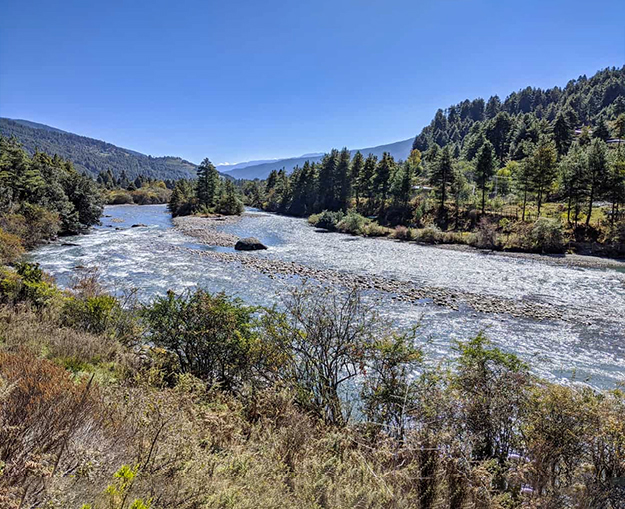
Kurjey Lhakhang, is one of the most holy and sacred sites in Bhutan, located in the Bumthang district. Nestled on the side of a hill, surrounded by 108 chorten walls, the complex houses three revered temples. The structures of the temples are as magnificent as the dzong, ancient fortresses in Bhutan. It has white washed walls with delicate wood carvings and hand paintings.

This is an interesting little journey that also involves crossing a seasoned suspended swing bridge that is covered in prayer flags.

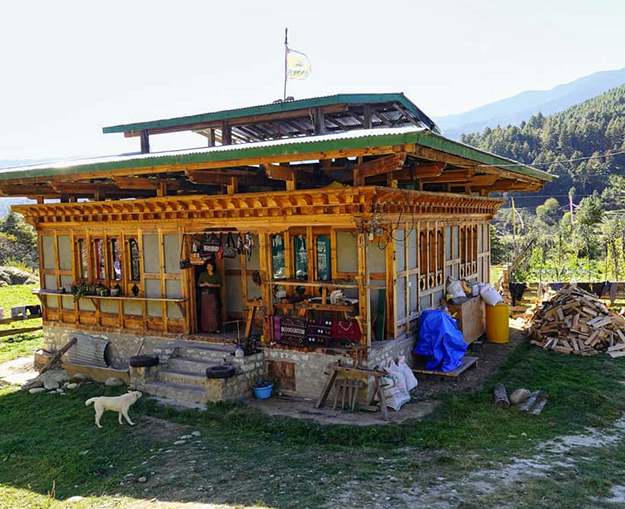
You can make a pit stop and visit the De-Gyal Handicraft and General Shop on the way to Tamshing Lhakhang.
The store specializes in hand-woven fabrics, purses, and clothes. Additionally, they have a wooden loom where they show you how to weave traditional Bhutanese textiles.
Tamshing Lhakhang was founded by one of the foremost of those Treasure Revelers, Tertoen Pema Lingpa, the year 1501AD. Later, the temple became the seat of the successive Sungtruls or Speech Reincarnations of Tertoen Pema Lingpa.
The armory in the temple, also cast by Tertoen Pema Lingpa, is a testimony of the saint’s renowned skill as a black-smith. Inside this temple, once also comes across the beautiful wall paintings by Pema Lingpa, and the throne that he built. We then have a special lunch planned for you at a home of a family where you will enjoy a bhutanese meal personalised for your palate.
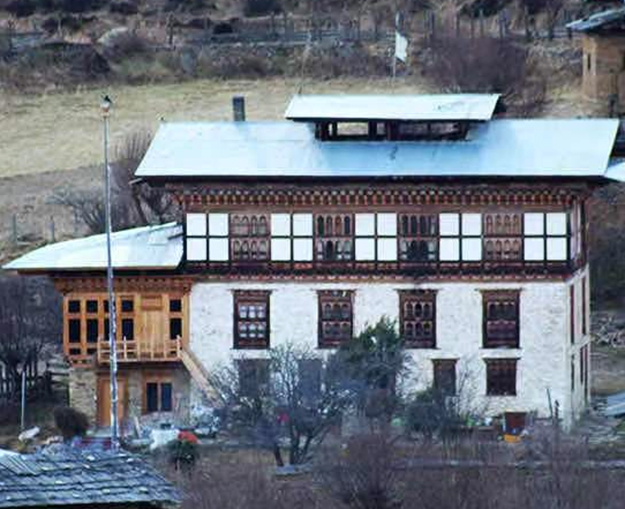

After lunch, we will drive to The Burning Lake, Mebar Tsho located along the way to the Tang village over the feeder road under Bumthang valley. It takes approximately thirty minutes’ drive to the Mebar Tsho from Chamkhar town. Mebar Tsho is considered one of the most sacred sites in the region as it is related to the renowned religious treasurer (Terton) Terton Pema Lingpa.
Pema Lingpa is considered an incarnated disciple of Padmasambhava who discovered treasure within the lake in late 15th century.
We will then head back to town and take you to the Red Panda Brewery and Cheese factory. The Red Panda Brewery and Swiss Cheese Shop come with an interesting story. In the 1960s, a young Swiss man called Fritz Maurer lived in Bumthang in Bhutan and established a small cheese production, producing Emmenthal and Gouda using state-of-the-art cheese making machines.
Next door is the brewery, the Red Panda, and it produces pale straw-coloured Hefeweizen. It is stil very popular today amonsgst locals and guests alike.

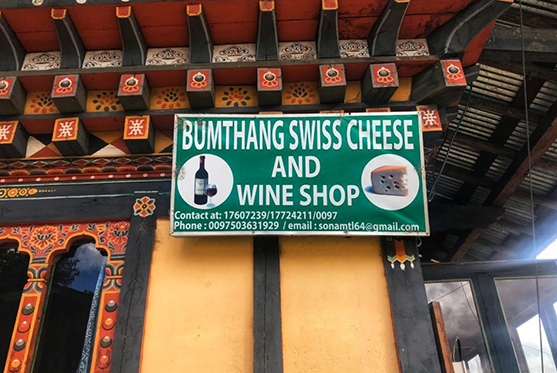
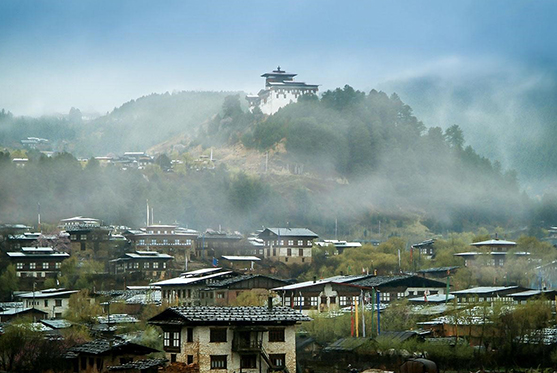
The rest of the day you can explore Chamkhar main town on your own. It is where all the shops, cafes, restaurants, pubs, snooker parlors etc are located. You can mingle with the locals and chit chat with them. Dinner will be planned for you in town. Overnight in Bumthang Valley.
Day 4. Day One of Brigdungla Trek – Zhurey village to Pongchen Camp. (B/L/D)
We begin our journey from the village of Zhurey, 28 kms away from Chamkhar town, connecting to the Ura bypass road. Brigdungla is perhaps one of the most unheard of places in Bhutan.



After a grueling ascent among giant spruce and pine trees, you will reach your first camp site. Amidst a small open meadow on top of the mountain surrounded by the darkening mountain silhouettes is a cozy log cabin.
Spend the night in your comfortable tents as you listen to the wind whistling through and the huffing of the horses outside.



Day 5 – Day Two of Brigdungla Trek – Pongchen to Tsemchi Campsite. (B/L/D)
The pinkish hue slowly turns warm as the morning sun rays slowly take over the sky. Today we will be leaving the treeline and enter the shrubs. We will be walking through the rhododendron gardens and passing by several lakes.
As we cross the tall spruce and rhododendron forests, we finally arrive at a clear space above the treeline. Sprawled with ballu and sullu shrubs, this is the point where you get to enjoy the views of the mountain ranges left behind and those that still await.

As the landscapes begins changing around us, you arrive at the top of the ridge what looks like a smooth green mountain range from the distance is a mountain of rocks filled with thorny shrubs.
These are not the velvety green meadows you see on postcards, it’s something more than you can imagine. If only these rocks could speak, maybe they would tell us a story of ancient rock palaces in the sky, the abodes of deities and spirits of rock castles and fortresses struck down by something unforeseen.


Towards the end of the second day of the Brigdungla trek, you’ll find yourself close to a sacred space that is revered by the people of this region in Bumthang. At the highest point of the trail 4521 meters stands what locals believe to be home of a mystical force: Mount Phola.

In Bhutan, we believe that spirits and deities reside in the land as supernatural entities as giant trees, rocks and mountains. Mount Phola is one such deity that this region of southern Bumthang worships. Mount Phola is a wonder of nature.
Rising from the earth, like a fist holding a norbu (precious jewel), the sight of the mountain emanates a powerful allure. The locals here always first pay respect to Phola before building a new house or performing a community ritual.

The majestic mountain is probably one of the main attractions of Brigdungla trek and you’ll come to understand how the landscapes here encapsulates everything that the highlands in Bhutan are all about from the many scattered lakes, unique vegetation, and breathtaking views to the ancient legends that are still close to the hearts of its people.
Day 6 – Day Three at Brigdungla. (B/L/D)
Today is extra day at Brigdungla. You wake up with a gorgeous panoramic view of the surrounding ridges around your camp. You will explore the view from up here.


After a hearty breakfast, you will climb the steep ridges, literally on all fours. You will feel proud at how much you have climbed and don’t worry about how much still lies ahead.
Your climbs will be exhilarating and rewarding. You’ll know it when you are here.
Day 7 – Day Four of Brigdungla – Tsemchi Camp to Wongbu Camp – (B/L/D)
After saying goodbye to Phola, we begin our four hour descent towards our next camp in Wongbu 4090m.
You will walk through some of the most beautiful landscapes in Bhutan and come across many lakes as we descent.

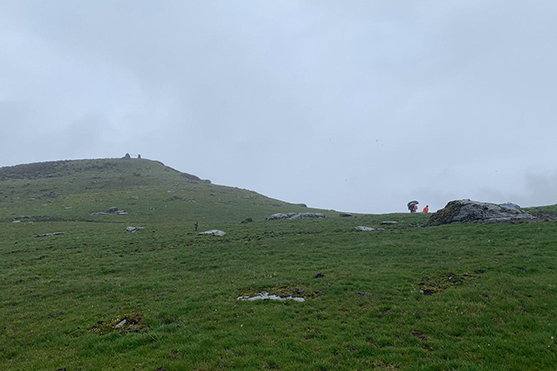
As we make our way down into the treeline zone in a small opening on top of the mountain stands one more log cabin built by the residents of Bim village.

The burning campfire create the perfect lighting, illuminating the beautiful campsite in the darkness of the mountains. Windy and cold but you find your warmth and solace inside this beautiful addition to the Brigdungla trek.
Day 8 – Day Five of Brigdungla – Wongbu Camp to Bim Village to Chamkhar. (B/L/D)
For your last day of the Brigdungla trek, we will plan a special experience for you to visit to the regions last yak herding gamily who stay at the bottom of the Wongbu camp hill.
Consider yourself very lucky because they are the last of their kind to live this nomadic life in these mountains. The beautiful setting in the mountains with herds of yaks in the background make for a great social media post, but rarely do we understand the difficult life behind it all.


Take the memories of the pink skies of Pongchen’s dawn. The memory of Phola’s majestic presence posed to allure yet another explorer.
The stories and anecdotes from your amazing team of people who makes your journey memorable. The moment you first saw the scattered lakes on the vast highlands and reflected on their sheer existence.
Create your own adventure and see for yourself the magic as you discover the lost trail of Brigdungla.
Day 9 -Bumthang to Phobjikha Valley. (B/L/D)
After a relaxing easy morning and a hearty breakfast, we drive to Phobjikha valley via Trongsa. We will have lunch along the way at a nice location. Phobjikha valley is known for its gorgeousness and timeless scenic splendor.
The beauty of the Phobikha valley is at its peak during the spring season; when the various rhododendron blossoms are found in abundance. And in late Autumn when the birds of heaven (Black Necked Crane) arrive in sweet deluge after the monsoon. Upon arrival we have tea/coffee and snacks for you at Gangtey lodge.

We take a short walk through the Nature Trail allowing you to immerse yourself in the alluring beauty of the Phobjikha Valley.
In this bewitching setting, tyou make your way from the Gangtey Monastery through dense pine forests, flower meadows, and grasslands to reach the bottom of the valley. With the smell of pine in the air and picturesque vistas, this nature trail offers you a chance to admire the vast green meadows.
Before we check into the hotel. We can visit the Crane information center – details of their habits and habitats, backed by some great photographs are available at the Crane Information Center. From here you can observe and get educated on these majestic birds.
The facility is operated under the aegis of the Royal Society for the Protection of Nature. If the birds are in residence when you visit Gangtey/ Phobjikha, you may be able to get a close view from the hides specially constructed for this purpose.

Day 10 – Phobjikha Valley to Punakha Valley. (B/L/D)
After breakfast, we drive to Punkaha Valley. The Punakha valley is enveloped by vast expanses of verdant paddy fields and dense clusters of forested hills. One of the warmest valleys, it also offers spectacular Himalayan views, exhilarating treks and serene temples.
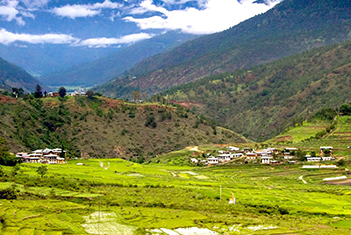
Upon arrival we will visit Chhimi Lhakhang known as the Fertility Temple, is a revered place of magic and miracles.
Blessed by the eccentric maverick yogi and saint Drukpa Kunley, known as the ‘Divine Madman’ and father of fertility, he had very unconventional ways of teaching and this Buddhist monastery is said to be a place of fertility and blessings.
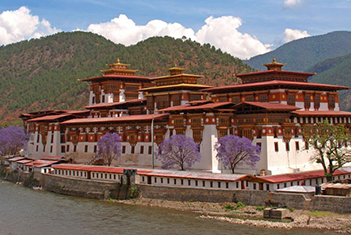
We then have lunch by the riverside and after a relaxing meal by the riverside, we will visit Punakha Dzong. Punakha Dzong is not only the second oldest and second largest dzong but it also has one of the most majestic structures in the country. October 13, 2011 marked an unforgettable wedding of the King of Bhutan, Jigme Khesar Namgyel Wangchuck to Jetsun Pema which was held at Punakha Dzong. Punakha Dzong was built at the confluence of two major rivers in Bhutan, the Pho Chhu and Mo Chhu, which converge in this valley. It is an especially beautiful sight on sunny days with sunlight reflecting off the water onto its white-washed walls.
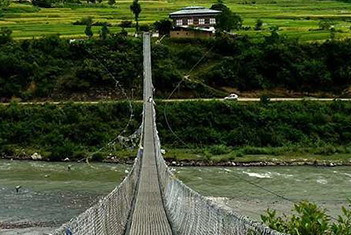
Before we head to the hotel, we will take a walk on the Punakha Suspension Bridge, which is always adorned with colorful prayer flags, is the perfect example of this. Linking Punakha Dzong to Shengana, Samdingkha, and Wangkha villages across the Tsang Chu River (aka Po Chu), this is one of the longest suspension bridges in Bhutan. Yet, for a roughly 520-foot-long suspension bridge, it’s surprisingly stable. The bridge offers a spectacular view of the river and valley, and the east bank is a good starting point for multi-day treks in the nearby mountains.
Evening at your leisure. Dinner at the hotel. Overnight in Punakha.
Day 11 – Punakha to Paro Valley. (B/L/D)
Breakfast at the hotel. We experience river rafting in the morning. Rafting in Punakha valley is the most popular soft adventure in Bhutan. The stunning view of the picturesque Punakha valley dotted with quaint villages and the Punakha Dzong anchored like a majestic ship between the Mo (female) and Pho (male) Chhu Rivers is why it is a must-try activity for you. Each second on the raft will serve your eyes with beautiful snippets of Punakha.
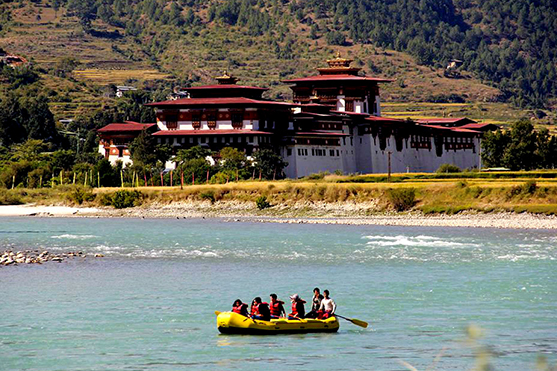
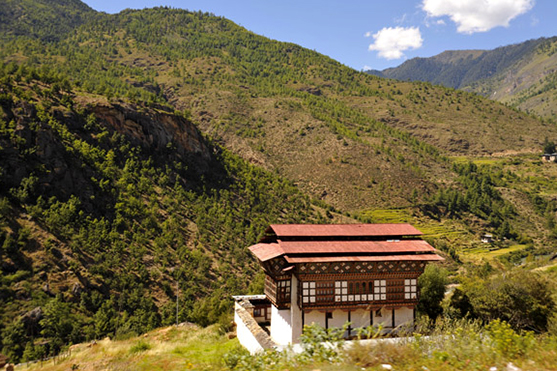
After this, we journey to Paro valley via Dochula pass. Lunch will be planned for you along the way at a farmhouse.
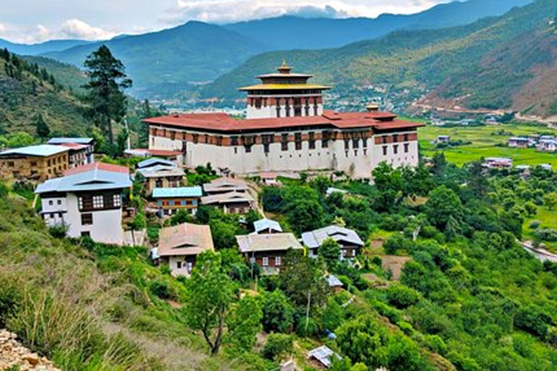
Upon arrival, visit the Paro Fortress – Paro Rinpung Dzong is a large monastery and stronghold of the Kagyu school of Buddhism. It translates as the Fortress on a heap of jewels. The approach to the Dzong is through a traditional covered bridge (called the Nemi Zam) . And then up to the paved stone path running alongside the imposing outer walls.

Before cheking into our hotel. Explore Paro town. A leisure walk along the main street of Paro town can be a unique experience. You can either choose to step inside a café and just gaze through the window to absorb the Bhutanese way of life while sipping a hot cup of coffee or they could explore the handicraft shops which have a collection of antiques and contemporary hand crafted products. Dinner at the hotel. Overnight in Paro Valley.
Day 12 – Paro Valley. Tigers Nest Excursion. (B/L/D)
Taktsang Lhakhang is Bhutan’s most iconic landmark and religious site. The name Taktsang translates to “The Tiger’s Nest”. This temple is one of the most holy sites in the kingdom and clings impossibly to a sheer cliff face 900 meters above the Paro Valley.


It was first built in 1692 at a cave where Guru Rimpoche meditated in the 7th century A.D. Legend states that Guru Rimpoche flew to the site atop the back of a tigress and meditated in the cave for 3 years, 3 months, 3 days and 3 hours in order to subdue evil demons residing within it.
The cave has been considered a sacred site ever since and many famous saints have travelled to meditate in it.
Taktsang Lhakhang is located approximately 10 km north of Paro town at an altitude of 3.120 m. In order to arrive at the temple visitors must trek for around 2-3 hours through beautiful, shady pine forests. No trip to Bhutan would be complete without a visit to this remarkable heritage site.
After the hike, experience a relaxing hot stone bath. The process of a traditional Bhutanese hot stone bath is unique. It uses Menchu (medicinal water) which is nothing but fresh river water mixed with Artemisia leaves. The water is heated using river stones that are roasted on fire till they are glowing red. The temperature of the water can be increased by adding more heated stones into a wooden chamber via a chute. This chamber is connected to the main tub (also made of wood) which contains the water.
The holes in the chamber allow the heat to be infused into the bath (so there is no danger of being burned by the hot stones) and the stones are said to release key minerals into the water which are believed to have medicinal benefits. One can soak in the water for about an hour or two after a tiring day while sipping a hot beverage.

The evening will be followed by a cultural show with local drinks for the guests and farewell dinner. Overnight at Paro Valley.
Day 13 – Farewell Bhutan. (Breakfast)
Breakfast at the hotel. Leave for Paro airport for your flight back. Bid goodbye to your travel team. Safe Journey.

WHAT’S INCLUDED:
- Private guided tour
- Visas for Bhutan
- Airport transfers
- Daily 3 meals (B/L/D) at designated restaurants or hotels
- Accommodation at 3 star Bhutanese hotels & resorts
- A qualified & licensed English-speaking guide
- An experienced driver
- A tour vehicle
- Entry fees & road permits
- Government sustainable development fees
- Daily refreshments
- Cultural show
- Full service & assistance before during and after your Bhutan trip
PRICES:
- For Travel during the months of: Oct, Nov, Mar, Apr,
- USD 5400 for 1 person traveler
- USD 5100 per person for 2 person travelers
- USD 4800 per person for group of 3 and above
INCLUDED ON TREK:
THE FACILITIES FOR CAMPING/ TREKKING INCLUDES:
- Daily 3 meals, tea, coffee, snacks.
- Sleeping tents, sleeping mats, sleeping bags & pillows.
- Dining tents, kitchen tent, shower, toilet tent.
- Tables, chairs, utensils, hot water bags.
- Trekking chef & assistants.
- Horses to carry trek equipment.
- Food supplies/ essentials, medicals, emergency equipment.
Equipment List
- Reading/writing material
- Binoculars,First-aid kit; should contain lip salve, Aspirin, Band Aids, anti-histamine, Imodium or similar tablets for mild cases of diarrhoea
- Re-hydration powder, extra prescription drugs you may be taking if any particular
- Wet wipes for cleaning can be purchased in Bhutan.
- Travel documents: passport, visa, travel insurance, air tickets, passport photo (4 copies min),Health requirements arranged
- Money: cash/credit card
- Money pouch
- Swiss army knife
- Spare Boot Laces
- Down Sleeping bag provided by the company
- Duffel bag
- Lightweight Towel
- Day pack to carry your personal needs during the day
- Alarm clock and torch/flashlight – headlamp style is ideal
- Insect repellent, sunscreen and lip balm
- Refillable water bottle – Min 1 Liter Aluminum or Nalgene polypropylene are best
- Warm Hat
- Sunhat/bandana ,Sunglasses
- Gloves – wool or fleeced and gore tex,Scarf,Sarong a multitude of uses
- Bag Liners to waterproof your bags (A duffel bag is provided with each trekker for trekking),Sewing Kit
- Wind and Waterproof Jacket & Pants ,Comfortable and sturdy walking shoes (worn frequently prior to departure) ,Socks: thick wool blend and thin cotton to be worn in combination – ensure boots fit such combination, Running shoes or sandals for evening
- Wool jumper/sweater/fleece. Lightweight during summer, 1 heavyweight or 2 lightweights during winter months.
- Fleece Jacket
- T-Shirts 2 or 3,Shirt – Long Sleeved
- Pants – lightweight long trousers (jeans are unsuitable),Thermals upper and lower
- Extra warm clothing during winter (December to March) layered clothing – thermals.
WHAT’S EXCLUDED:
- Flight into Bhutan via Drukair (can be arranged with us)
- Flight on other airline to catch Drukair Flight
- Meals at 5 stars restaurants
- Hotel stay outside of Bhutan
- Expenditure of personal nature
- Travel Insurance
- Gratuity for the guide and driver
- Alcoholic drink
HOTELS IN BHUTANBHUTAN

HOTELS IN THIMPHU

HOTELS IN PUNAKHA

HOTELS IN PARO

HOTELS IN Phobjikha valley
